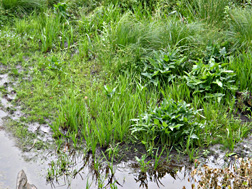Features of Climate
Keep it Simple
Understanding our climate and all the factors that result in our weather is an extremely complex subject. Fortunately we don't have to understand all the detail in order to plan for the effects of the weather on the design of our gardens.
The main elements of climate that will influence the plants we choose for our garden are:
Temperature
In general, the growing season – that part of the year when most plants are actually growing - is determined by the soil temperature. Most growth takes place when the temperature is above 45oF, which in turn is affected by such factors as the amount of sunshine and the altitude.

When the soil temperature falls, most plants become dormant. However when it falls below freezing, it causes particular difficulty for many plants (some more than others). Freezing temperatures mean that water is no longer available to the plants and for more tender plants the cells can rupture which will eventually kill the plant.
Clearly, therefore, you need to take into account the average temperature, as well as typical maximum and minimum temperatures when deciding what you can grow outdoors, unless you are prepared to provide appropriate protection against extreme temperatures.
Hot Weather
Excessive heat is not normally a problem for gardeners in the UK. However, with the climate changes associated with global warming, we are advised that extreme weather events may become more common in future.
Lengthy periods of excessive heat, therefore, may become a problem in UK gardens with plants that are more used to a temperate climate.
Problems can arise when temperatures rise above 30C (or mid 80s Fahrenheit) for prolonged periods. Most plants in UK gardens don't like these temperatures and start to close down. In effect they are protecting themselves and attempting to survive until temperatures become more comfortable.
This closing down can occur even though the plants have ample supplies of water, although if they are experiencing drought conditions at the same time, they will complain all the more and you will be much more likely to lose them.
In practice, although they won't like it, most plants will survive but possibly not produce the flowers, fruit or what have you that you were expecting. Just be patient until next year when hopefully the weather will return to something like normal.
Wind

Particularly strong winds can cause physical damage to plants by snapping stems or breaking branches. In extreme cases, plants may even be uprooted. However, even less violent but persistent wind can cause problems. Most people have seen trees or hedges that appear to be permanently blown in the direction of the prevailing wind. This phenomena is not, in fact caused by the strength of the wind but by the cooling and drying effect that kills off the buds on the side of the plant facing into the wind.
If your garden suffers from persistent wind, then you usually need to incorporate some form of shelter into your design.
Solid barriers such as a wall or close fence are not usually a good idea because they tend to create down draughts in the vicinity of the barrier on both sides. These down draughts can be damaging for many plants.
A better option is some form of open fence or even better to plant a hedge, which doesn't try to stop the wind completely but moderates the wind speed in a gentle way and thereby reduces the harmful effects.

Rainfall
All living things need water and most plants get all the water they need from rain. As long as it isn't too heavy and there are no periods of prolonged drought, most plants will thrive without any intervention.
Some plants are particularly tolerant of drought conditions, either because they are able to store emergency supplies of water or because they can adopt a dormant state until the next rains come. On the other hand, there are many other plants that cannot survive without a fairly constant water supply so that you may need to provide artificial irrigation in times of drought.
Read more about Climate and Weather |
Read more about Soil and Climate |
